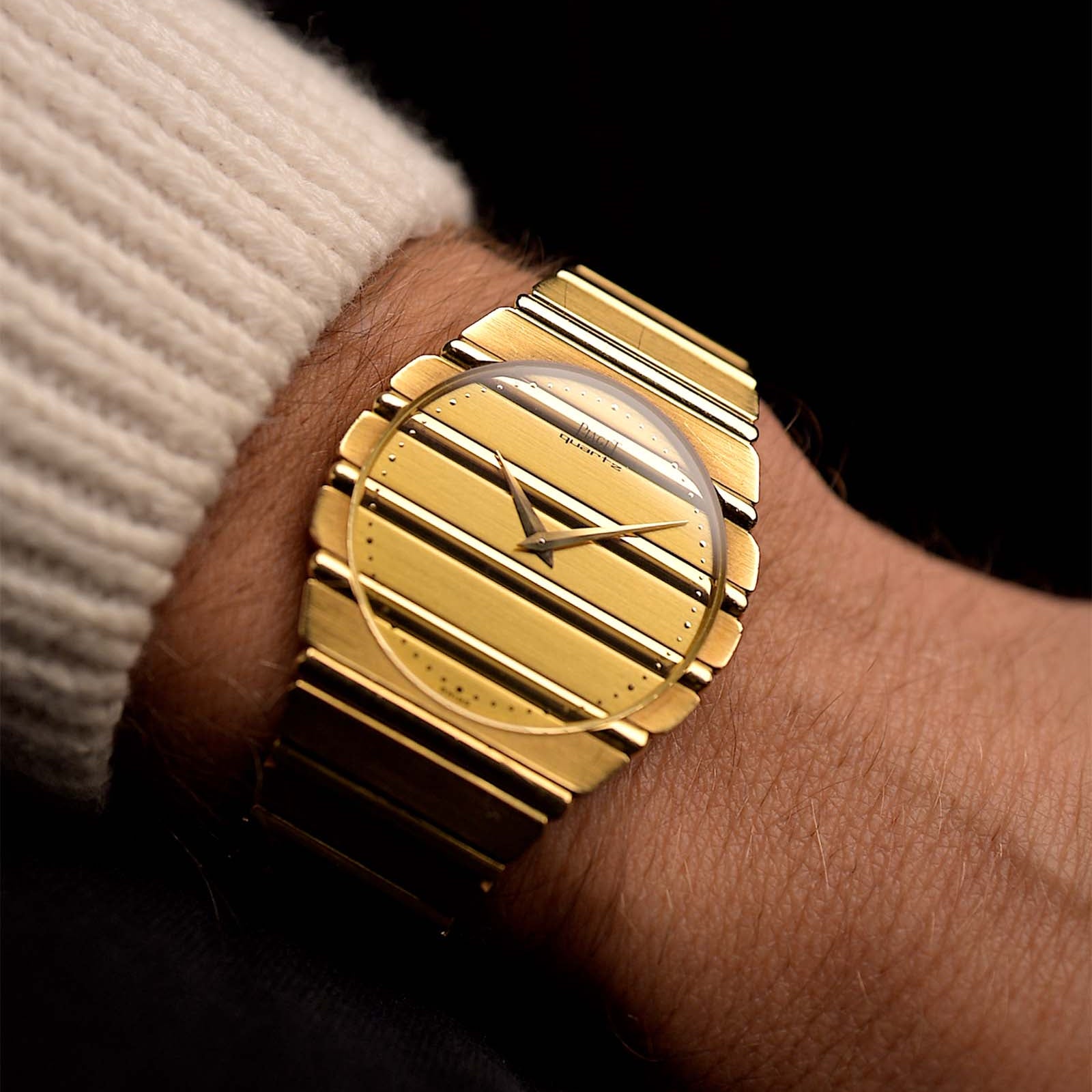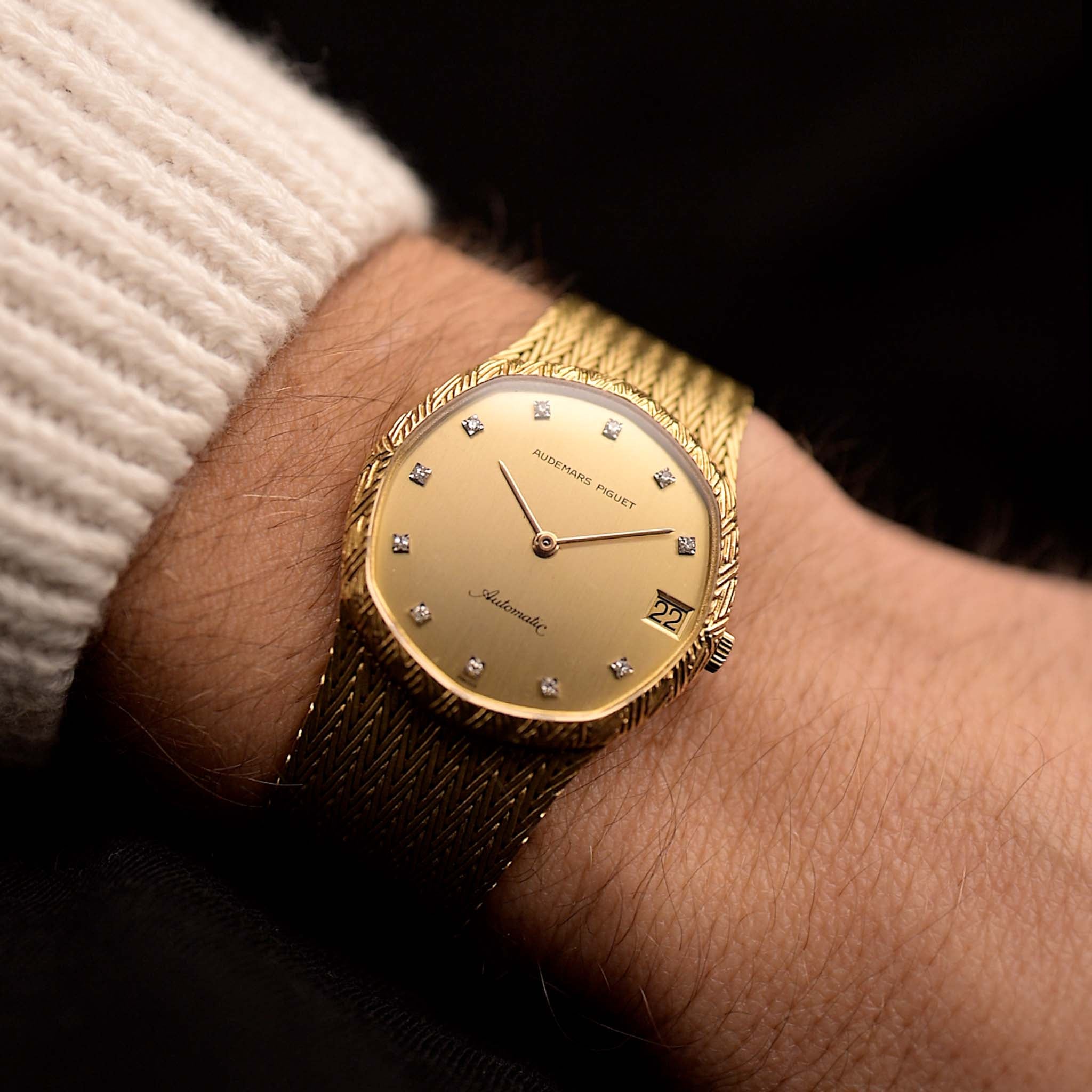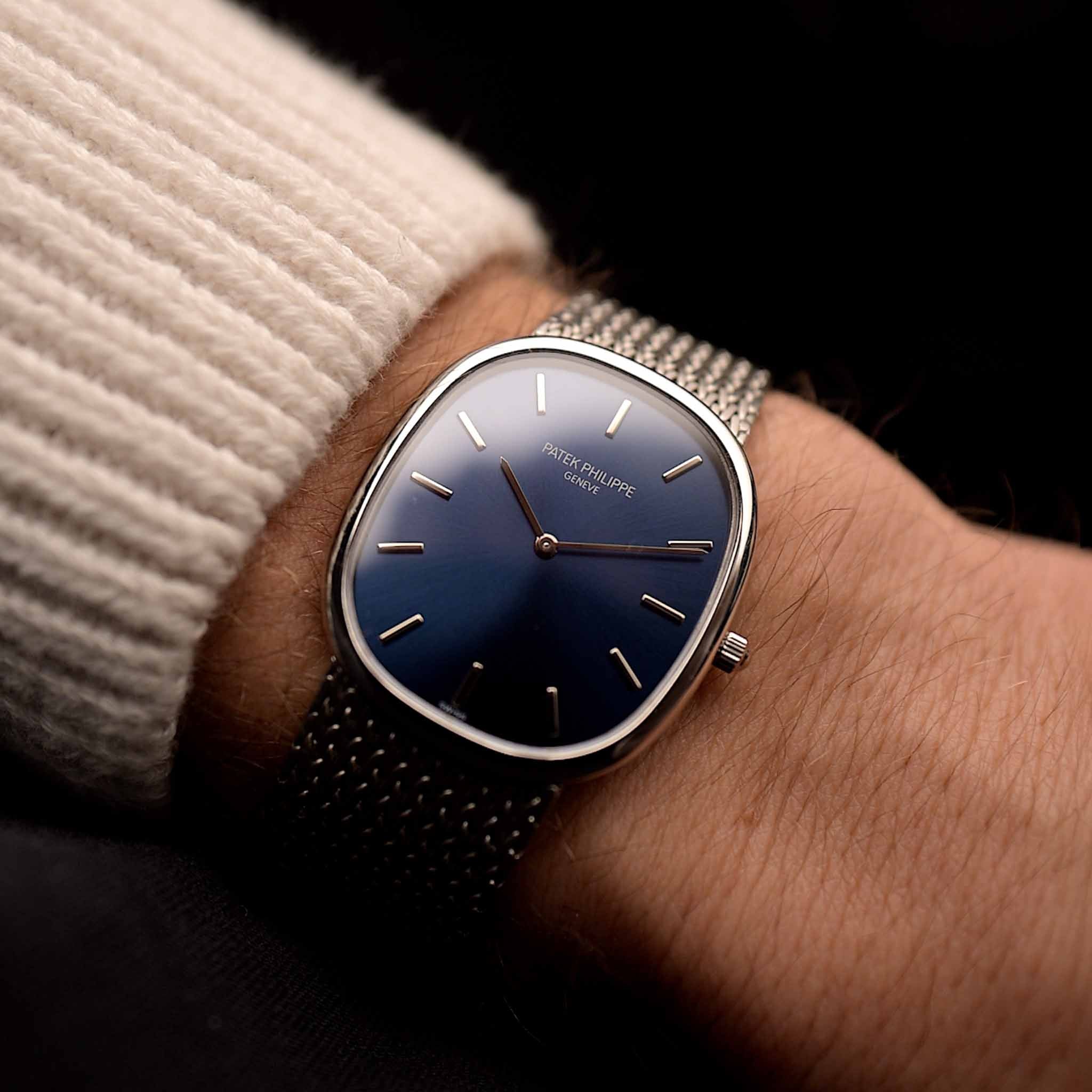Gerald Genta wasn't just the Royal Oak, or the Omega Constellation C, or his eponymous brand. As LVMH just announced the re-launch of his brand with help of his widow and a large pile of unreleased sketches we are interested in what he did stand for... What ideas and principles transcended the work he did for each brand throughout a five-decade long career?
July 5, 2023
A Deep Dive into Gerald Genta's Design Legacy

Marcus Siems @siemswatches
Collector, Author, Data Analyst
The Legend Gerald Genta wasn't just the Royal Oak, or the Omega Constellation C, or his eponymous brand. As LVMH just announced the re-launch of his brand with help of his widow and a large pile of unreleased sketches we were wondering what he did stand for... What ideas and principles transcended the work he did for each brand throughout a five-decade long career? Are there common themes that could make us better understand the philosophy of the watch world's first and probably biggest designer?
I feel a bit like I'd need to apologize as this topic might be overcrowded with opinions and articles already written and published. Yet this will be a slightly more analytical piece on the horological world's 1st holistic watch designer - the SiemsWatches approach if you want. It'll be less about the watches but more focused on the design cues that make a Genta design, overarching brands, eras and styles.
Connecting all the dots I'll try to establish a few basic principles of Genta's design lineage from the early years during the 1950s all the way up until the 1990s. In sum I'd argue there are (at least) four core principles his designs gravitate around - 1) increments of time, 2) encapsulating time, 3) the time's embrace, and 4) redefining time. And below I'll explain in more detail what I mean with these rather unusual descriptions.
 There's a certain vibe that makes a Genta design stick out immediately... So what is it? Photo @Goldammer.me.
There's a certain vibe that makes a Genta design stick out immediately... So what is it? Photo @Goldammer.me.
Intro) The Design Chronology (and excerpt)
But before we go into the comparative work let's start with an overview. In total, Genta supposedly sold hundreds if not thousands of designs to various manufacturers. He wasn't always employed directly but more of a self-made freelancing designer from a pretty young age on[1].
 An illustrous group picture of some of the most influential designs (and attributed designs) from Gerald Genta throughout the years. Quite variable, quite versatile yet I'll argue that many of those share common core principles. Photos Courtesy of Christie's, Hodinkee & IWC Schaffhausen.
An illustrous group picture of some of the most influential designs (and attributed designs) from Gerald Genta throughout the years. Quite variable, quite versatile yet I'll argue that many of those share common core principles. Photos Courtesy of Christie's, Hodinkee & IWC Schaffhausen.
1) Increments of Time
Or what else can hint towards elapsed time on a watches face besides the hands. For many of the watches presented above, as well as several others, you will find hidden ways to subdivide time into smaller increments. Let's have a closer look at the Polerouter to get from the abstract to the concrete level of description.
Looking at the outer rim of the dial we see a - for the time - rather unusual set of hour markers. It's not only classic markers but a full engine turned scale depicting to the tenth of a second ingested into the dial.
 Taking a closer look at a Universal Geneve Polerouter's dial and the engine turned rim. It's technically not part of the bezel as it sits within the glass but we'll come to that in a bit. Photo @Goldammer.me.
Taking a closer look at a Universal Geneve Polerouter's dial and the engine turned rim. It's technically not part of the bezel as it sits within the glass but we'll come to that in a bit. Photo @Goldammer.me.
With the Polerouter this additional design display of time sits within the bezel but the following blueprints the bezel often became the cornerstone of exactly this sub-conscious subdivision of time. The Disco Volante is the most obvious out of the depicted examples as so many diverse and salient options exist.
Many examples - particularly during his early years - featured this design detail. The fluted bezel on the Constellation C-Shape is another one. Even the screws on the Royal Oak as well as the recessions on the Ingenieur SL can be counted into this particular category. Well it even shows in his namesake brand's Bi-Retrograde outer case flank.
 A Disco Volante with an almost opulent bezel taking the engine turned incrementing of time to a whole new level. Here, in the form and shape of a Universal Geneve example. Photo Courtesy of @SiemsWatches.
A Disco Volante with an almost opulent bezel taking the engine turned incrementing of time to a whole new level. Here, in the form and shape of a Universal Geneve example. Photo Courtesy of @SiemsWatches.
2) Encapsulating Time
All in all this part is about case shapes. I know, I know these titles are a bit cryptic but when it comes to design I always feel like getting a bit creative myself. I've made the point before that each and every case-shape had its time but especially the 1960s and 70s were an era of liberation from the boundaries of the round watch case.
Looking into Genta's magnum opus he definitely was no stranger to this trend. Starting (at least) in 1962 he was already experimenting with angled case designs conceiving one of the most un-Rolex Rolex watches in probably ever, the pentagonal King Midas[2].
 As extravagant (and limited) as you will ever get with a design coming from Rolex. Sitting on top of it's - not box but - urn is a white- and yellow-golden striped reference 4915 King Midas. Photo Courtesy of Christie's Geneva May 2022.
As extravagant (and limited) as you will ever get with a design coming from Rolex. Sitting on top of it's - not box but - urn is a white- and yellow-golden striped reference 4915 King Midas. Photo Courtesy of Christie's Geneva May 2022.
Think of a polylateral and Gerald Genta probably had a design for it. There's the square Nautilus and Golf Club, the hexagonal Da Vinci (attributed[3]), the octogonal Royal Oak, you name it. On top, also one of the most influential and holistically designed shaped dress watches, the Golden Ellipse, keeps getting attributed to him[4] even though he was "only" an inspiration[5]. And when we're talking shapes don't overlook the Pasha with its grill.
3) Time's Embrace
When we speak about Genta classics these days what comes to mind first are AP's Royal Oak and Patek Philippe's Nautilus, the hype-beasts of our generation. And because of the attention to those models we speak a lot about integrated bracelets. A defining factor of the sports watch genre and a detail mostly attributed to Mr. Genta as well.
 What can I say... it's an integrated bracelet luxury sports watch designed by Genta - two years prior to the Royal Oak. And to put names to it: An IWC ref. 3501 with Beta21 movement and bark finish. Photo Courtesy of Casmiko.
What can I say... it's an integrated bracelet luxury sports watch designed by Genta - two years prior to the Royal Oak. And to put names to it: An IWC ref. 3501 with Beta21 movement and bark finish. Photo Courtesy of Casmiko.
And that's exactly true. Gerald Genta was, if not the inventor of, the most prominent figure in making integrated bracelets as important as they are today. Yet funnily enough Genta's bracelet story didn't start at Audemars Piguet's or Patek Philippe's headquarters but at Rolex. Already 10 years prior to the introduction of the Royal Oak in 1972, the aforementioned King Midas came to the market.
And it didn't stay the only iteration. Rolex alone (as lore has it) took another of Genta's sketches for their first Quartz watch, the Beta21 powered reference 5100 Texano in 1970[6]. A similar oddball reference with an integrated bracelet and Beta21 movement came from Schaffhausen about a year prior - the initial Da Vinci reference 3501. An 18k full-golden hexagonal grail of electronic watchmaking history.
 A classic Gerald Genta piece bringing together several of his core design principles. Here in a 1990s Perpetual Calendar with Moonphase and onyx bezel and integrated bracelet in yellow gold. Photo Courtesy of Christie's HK Sep. 2021.
A classic Gerald Genta piece bringing together several of his core design principles. Here in a 1990s Perpetual Calendar with Moonphase and onyx bezel and integrated bracelet in yellow gold. Photo Courtesy of Christie's HK Sep. 2021.
And the list goes on... after the Royal Oak and the Nautilus we also got the Ingenieur SL (1976, as well as other Steel Line models from IWC), Credor's Locomotive (1979), the Cartier Pasha (1985) and several of his creations under his own brand like the "Gold and Gold" and the "Success".
4) Redefining Time
In a way "redefining time" is the perfect link to the very first point I made. A principle that became particularly evident in Genta's late work. While in his earliest creations the perception of time was mainly altered by design, Genta would later also be known for his complications*.
 A new way of indicating time and I'm not speaking about Mickey here. This is a retrograde minute complication with an additional jump hour - a first for the horological world from Genta's own brand. Photo Courtesy of Christie's HK May 2022.
A new way of indicating time and I'm not speaking about Mickey here. This is a retrograde minute complication with an additional jump hour - a first for the horological world from Genta's own brand. Photo Courtesy of Christie's HK May 2022.
While Genta was a designer on paper he also had a quite good understanding of the underlying functioning of his timepieces. From his earliest days at Universal Geneve on he was heavily involved in the mechanics of his pieces[1].
Under his brand he introduced for example the retrograde minute in combination with a jump hour movement and later further including a retrograde date as well. This might sound like "only" a mechanical gimmick but it completely redefines how the passing of time is displayed on a watch.
 The Biretro complication from Genta. Retrograde date and minute combined in a jump hour movement. A reinterpretation of time. Oh and by the way it no coincidence this looks like the blueprint for Bulgari's Octo Finissimo[7].
The Biretro complication from Genta. Retrograde date and minute combined in a jump hour movement. A reinterpretation of time. Oh and by the way it no coincidence this looks like the blueprint for Bulgari's Octo Finissimo[7].
So hear me out. On a "normal" watch seconds, minutes and hours move in a circular fashion. Hereby, time is ongoing, infinite and repeating. On a jump hour and retrograde minute watch each hour forms its own entity. It is a perceivable digital unit that is in a sense detached from what happened before and what might come after. This means no happy face hand setting but also that the design itself stays unaltered independent of the moment.
5) Conclusion
Putting one and one together we're looking at a designer's legacy who tried to completely overhaul and re-interpret the wrist presence of a watch and the concept of time itself. How does a watch fit to your wrist? How are the different parts, formerly produced in various places, connected, building one unit? How do we perceive time? All these are question that haven't really been asked before Genta started his journey and are still to this day often ignored. Too many "new" designs just drawn according to the books.
 Inspired by Genta and conceived by Rubli for Audemars Piguet and Patek Philippe[7] yet still one of my favorites - a golden circle for a blue dialed Patek Philippe Ellipse on a beads of rice bracelet. Photo @Goldammer.me archives.
Inspired by Genta and conceived by Rubli for Audemars Piguet and Patek Philippe[7] yet still one of my favorites - a golden circle for a blue dialed Patek Philippe Ellipse on a beads of rice bracelet. Photo @Goldammer.me archives.
Displaying time differently by design and functionality and playing with shapes through integrating the bracelet and unheard of case constructions is what makes Genta watches feel so unique. These guidelines - deliberately set or intrinsically arising - were for sure one of the reason for his success. Importantly, it evolved over time.
With Genta you can trace well how earlier designs feed from different principles than later ones. The attempts to play with the time display are evident in his first creations as both the Polerouter (1954) and Disco Volante (1954) already play with marker and bezel design. The King Midas 9630 from 1962 is - I would strongly argue - the first real insight into what Genta's designs would become later on. On top we got the inspiration taken from the antique. It is thus in my humble opinion one of the most important pillars of his design legacy!
 I argue that this design is pivotal for the legacy of Gerald Genta - it is the Pantheon (Rome) inspired pentagonal watch with integrated bracelet. These comprise for the first time core design features that he is celebrated for in our modern watch world. Photo Courtesy of Ben Dunn at Watch Brothers London.
I argue that this design is pivotal for the legacy of Gerald Genta - it is the Pantheon (Rome) inspired pentagonal watch with integrated bracelet. These comprise for the first time core design features that he is celebrated for in our modern watch world. Photo Courtesy of Ben Dunn at Watch Brothers London.
To describe what Gerald Genta stood for and to boil everything down as much as I can, I would point you towards: the Universal Geneve Polerouter dial, the Rolex King Midas case and bracelet construction as well as the way time is displayed on the Gerald Genta Jump Hour Retrograde Minutes.
But we must also say that when you're the first - like Genta was the first holistic watch designer of his generation - everybody else will have to at least fill your footsteps. The crazy thing is that Gerald Genta was so good in reinventing himself** and his designs while at the same time staying true to the meta-principles I just outlined that we still measure everything up to his legacy.
* Somewhat of a middle-ground between design and complication for re-inventing the display of elapsed time is the LCD display, another element used by Genta for the Bulgari Roma for example[8].
** Another option is that he just did so much that we can cherry-pick just the very best of the best of his designs... It's a fallacy yet at the same time very human.
References
[1] Iconic Models; Gerald Genta Heritage;
https://www.geraldgenta-heritage.com/iconic-models
[2] Reference Talk - Rolex King Midas; Ben Dunn, Manuel Knospe & Gai Gohari, WatchBrothersLondon;
https://www.watchbrotherslondon.com/articles/reference-talk-rolex-king-midas
[3] IWC's DaVinci through the Europastar archive; Stephen Foskett, Europastar;
https://www.europastar.com/the-watch-files/richemont/1004091989-iwc-s-da-vinci
[4] Gerald Genta: The Mind Behind Design; Ripley Sellers, Bob's Watches;
https://www.bobswatches.com/rolex-blog/resources/gerald-genta-mind-behind-design.html
[5] Gerald Genta, A Historical Interview; Constantin Stikas, Very IMportant Watches;
https://www.veryimportantwatches.com/el/articles/news/gerald_genta_a_historical_interview
[6] Rolex Oysterquartz Ultimate Guide; SwissWatchExpo;
https://www.swisswatchexpo.com/TheWatchClub/2023/02/02/rolex-oysterquartz-ultimate-guide/
[7] 10 of the best Gerald Genta designs for other brands; Zach Blass, Time&Tide Watches;
https://timeandtidewatches.com/10-of-the-best-gerald-genta-designs-for-other-brands/
[8] The History of Bulgari Watches; Allesandro Mazzardo, TimeAndWatches;
https://www.timeandwatches.com/p/the-history-of-bulgari-watches.html
All Rights on the text and graphics reserved to the Author.




























1 comment
Vielen Dank für diesen ausführlichen Artikel!
Allerdings hoffe ich immer noch etwas mehr über die frühen Jahre von Gerald Genta zu erfahren, da ich eine Uhr besitze, von der ich vermute, dass er das Gehäuse entworfen hat.
Es handelt sich um eine frühe Girard Perregaux, eine Gyromatic von 1958.
Das Gehäuse ist wirklich speziell, aber ich weiß nicht, ob er in dieser Zeit auch für diesen Uhrenhersteller gearbeitet hat.
Falls Sie mir da irgendwie weiterhelfen könnten wäre ich Ihnen sehr dankbar.
Mit freundlichen Grüßen aus Berlin
Christoph Merg
Leave a comment